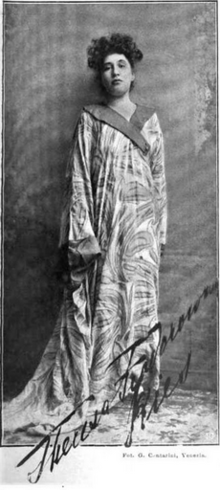
Teresa Feoderovna Ries (30 January 1866, Budapest – 16 July 1956, Lugano) was a Russian-born Austrian sculptor and painter. The year of her birth has also been given as 1866 and 1877.
Life and work
Teresa Ries was born in Hungary to a Jewish family. She attended the Moscow School of Painting, Sculpture and Architecture. She was expelled for showing disrespect toward a professor in one of her classes. She moved to Vienna at the age of 21, where her first exhibition at the Vienna Künstlerhaus included Witch, a sculpture of a nude woman clipping her toenails. This piece caught the attention of Kaiser Franz Joseph I, and she soon became highly celebrated throughout Vienna. The exhibition was also attended by Gustav Klimt, an active member of the Vienna Secession movement, who asked her to exhibit with them. She sought out Edmund Hellmer as a mentor; at first he refused, saying that "it was pointless to teach women since they married anyway". Hellmer eventually relented and helped her to exhibit her work and to gain commissions.
In 1900 Ries exhibited at the Paris World's Fair and the 1911 World's Fair in Turin on the invitation of both Russia and Austria. Prince Aloys of Liechtenstein offered her the use of a suite of rooms beside his own picture gallery as a studio.
Working in stone, marble, plaster, and bronze, Ries produced both private and public works during her career. Some of her well-known nude sculptures are Sleepwaker (pre-1894), Lucifer (c. 1897), and Death (1898). She produced sculptures and busts for public spaces; her Bust of Jaromir Mundy (1897) is mounted on the outside of the Vienna Fireman's Association building. She is perhaps best known for photographing and creating a bust of Mark Twain during the time he resided in Vienna.
According to art critic Karl Kraus, "her exhibitions received too much publicity". Ries published her memoir, Die Sprache des Steines (The Language of Stone) in 1928. In 1938 she was evicted from her gallery and studio space due to the Nazi policy of Aryanization. She continued to work in Vienna until 1942 and then immigrated to Lugano, Switzerland.
Personal life
Ries married, lost a child, and divorced while still a teenager in Moscow.
Legacy
Her work was included in the 2019 exhibition City Of Women: Female artists in Vienna from 1900 to 1938 at the Österreichische Galerie Belvedere.
References
- Trenkler, Thomas. ""Soll alles dem jüdischen Volk gehören"". Kurier. Retrieved 18 December 2023.
- ^ Ben-Eli, Birgit (1 March 2009). "Austria: Jewish Women Artists". Jewish Women: A Comprehensive Historical Encyclopedia. Jewish Women's Archive. Retrieved 26 June 2016.
- ^ Johnson 2012, p. 205.
- ^ "The Forgotten Women Artists of Vienna 1900". 24 June 2012.
- ^ Johnson 2012, p. 209.
- ^ Johnson 2012, p. 203.
- Johnson 2012, p. 207.
- Johnson 2012, pp. 1–2.
- Johnson 2012, pp. 203–204.
- Johnson 2012, p. 208.
- Johnson 2012, pp. 218–219.
- "Literary Pickups". Book Notes: A Monthly Literary Magazine and Review of New Books. 1: 288. November 1898.
- ^ Ivry, Benjamin (12 January 2013). "Turn-of-Century Vienna Artists Deserve Second Look". The Forward. Retrieved 26 June 2016.
- Johnson 2012, p. 2.
- "City of Women". Belvedere Museum Vienna. Retrieved 26 June 2020.
Sources
- Johnson, Julie M. (2012). The Memory Factory: The Forgotten Women Artists of Vienna 1900. Purdue University Press. ISBN 978-1-55753-613-6.
- Anka Leśniak: Teresa Feodorowna Ries and The Witch. Art and Documentation, 21, 2019, pp. 143–158
- 1866 births
- 1956 deaths
- Artists from Moscow
- People from Moscow Governorate
- Jewish Russian artists
- Emigrants from the Russian Empire to Austria-Hungary
- Austrian people of Russian-Jewish descent
- Russian women painters
- 20th-century Austrian painters
- Members of the Vienna Secession
- Jewish women painters
- Jewish painters
- Jewish women sculptors
- Jewish sculptors
- Austrian women sculptors
- Sculptors from Vienna
- Painters from Vienna
- Jewish emigrants from Austria after the Anschluss
- Moscow School of Painting, Sculpture and Architecture alumni
- 20th-century Austrian women painters